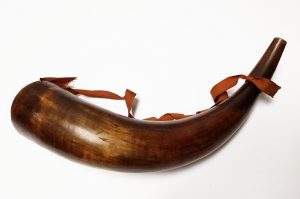An old musket, a sword, a powder horn hanging on the wall or even stored away in a closet. What types of military collectables have monetary and historic value in today’s market?
Over the years I have seen some wonderful historic objects that have been stashed away in a home for years, not enjoyed or even looked at by their owners. Sometimes they are shocked when they realize the value they actually have. For example, an old powder horn with no carving may not be worth much, but one identified to a soldier from the American Revolution can be of considerable value. Research can be done and the battles the individual fought in can be identified. A search of service and pension records can shed more light on the person who carried it and add to the monetary and historic value. The same can be done with a sword that has an inscription. A little bit of research can go a long way.
Muskets, especially early ones, have the possibility of being altered and updated over time. A flintlock in its original form will be worth more than one that might have been altered, or “updated” in the 19th century to percussion. Regimentally marked muskets can also be very valuable if identified to a unit of some importance.
Early accoutrements like cartridge boxes and canteens can bring a great return also. For some collectors and museums, these objects carried by a soldier are prized possessions that help them understand the era of their interests and the material culture of the time. They can be a direct connection to the past and the tumultuous events of war.
Some objects can still have a value while not being as historically important. Thousands of swords and other material was made for the Civil War. While some items may be worth in the hundreds of dollars, others can be thousands. Condition is important for the value also. A Colt percussion revolver with finish can do quite well while one without any is considered less attractive and less expensive.
Clothing can also be valuable to the collector. Early uniforms through the Civil War are highly collectable and as above, condition and provenance are a factor. The stories I have heard from some folks who cut the buttons of a garment and threw it away because of some mothing have always made me sick to my stomach. On important cloth, restoration can be done to keep it together without tossing a piece of history in the garbage.
Like any collecting genre some items have dropped in value over the years, but for the most part the historic material still does quite well. What do you have in your attic?





